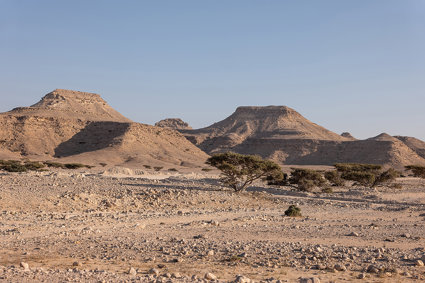
Carbon capture in Oman
Aim and introduction
Carbon capture is a method to reduce carbon dioxide in our atmosphere. It is important in combating climate change. In Oman, a country in the Middle East, vast geological formations called ophiolites are rich in peridotite offer a natural solution for storing carbon dioxide CO₂. The prize-winning Omani company 44.01 is pioneering this approach by turning carbon dioxide into rock.
44.01 won the Earthshot Prize in 2022 in the ‘Fix Our Climate’ category. The company’s Project Hajar in the UAE was named an XPRIZE Carbon Removal Top 20 Finalist.
Since 2022 the company has received a total of $42 million in funding. It is now working to further develop and commercialise its technology.
In this lesson students will learn about the geology of peridotite, an important rock in the carbon cycle, and the process of carbon capture in Oman. They will also learn about the award-winning Omani company, 44.01.
This lesson will take between 45 and 60 minutes.
Curriculum links
AQA 3.1.1.4 Water, carbon, climate and life on Earth. Human interventions in the carbon cycle designed to influence carbon transfers and mitigate the impacts of climate change.
Edexcel Topic 6: The Carbon Cycle and Energy Security. 6.9 Further planetary warming risks large-scale release of stored carbon, requiring responses from different players at different scales.
OCR 1.1.3 Option C – Dryland Landscapes. 4.b. The global implications of water and carbon management.
WJEC 3.1: Water and Carbon Cycles. 3.1.7 Carbon stores in different biomes.
Learning goals
1. Know what carbon capture is and why is it important in the fight against climate change.
2. Understand the chemistry of mineralisation.
3. Use the case study of 44.01 as an example of effective climate action in Oman.
Learning outcomes
Greater depth: Students will be able to describe in detail the global distribution of ophiolite rock formations, and the significance of the Oman Ophiolite Belt, which contains abundant peridotite. They will be able to explain what carbon capture is and, using specific scientific language, mineral carbonation. Some will be able to correctly label a diagram of mineralisation. Some might be able to reorder the chemical equation for the process.
Expected level: Students will be able to describe the global distribution of ophiolite rock formations, and the significance of the Oman Ophiolite Belt, which contains abundant peridotite. They will be able to explain what carbon capture is and mineral carbonation. Some will be able to correctly label a diagram of mineralisation.
Working towards: Students will be able to describe the global distribution of ophiolite rock formations, and the significance of the Oman Ophiolite Belt. They will be able to explain what carbon capture is and mineral carbonation.
Key terms
Peridotite
Peridotite is a dense, coarse-grained igneous rock that is primarily composed of the mineral olivine, which gives it a green hue. It does not naturally contain significant amounts of CO₂.
Mineralisation
Mineralisation is a broad term the formation of minerals. Mineral carbonation specifically refers to the chemical reaction where CO₂ reacts with minerals, such as peridotite.
Negative emissions technology
Negative emission technologies are methods designed to remove CO₂ from the atmosphere and store it permanently. These technologies aim to achieve ‘negative emissions’ meaning that they remove more CO₂ than is emitted.
Challenge and support
To challenge students read this document and follow the Ask students subheadings. Encourage them to research the geology of Oman in more detail, particularly the Hajar Mountains.
To support students consider reducing setting up the experiment in advance of the lesson, with the string and sugar solution ready for use. A key word and definitions crib sheet will help.
Starter
Map
Ophiolite is a rock formation, or suite of rocks that often includes rocks such as limestone, basalt, gabbro, and peridotite.
The ophiolite rock formations represent a section of Earth's oceanic crust that has been uplifted above sea level through tectonic processes, such as subduction or continental collision.
The map in the PowerPoint shows the global distribution of ophiolite belts. These linear regions of uplifted and exposed rock reveal multiple layers of rock, one of which is peridotite.
1. Ask students to describe the distribution of ophiolite (sample answer is in italics below).
Ophiolites are distributed globally and are found on every continent. There are very few locations in Africa, found only in the east and northeast of the continent. There are notable examples in the Alps, Himalayas, and the Middle East, including Oman. Peridotite is a key rock type in ophiolites, providing a valuable insight into the history of oceanic crust and plate tectonics.
Main 1 – what is carbon capture?
Video
Carbon capture is a new technology that has the potential to help in the fight against climate change. It is also seen as a controversial idea and a possible distraction from the goal of net zero.
Ask students to watch the Financial Times video and answer the following questions (suggested answers are in italics).
1. What needs to happen ‘long term’? 0:40
Long-term we really need to change the system rather than using same old fossil fuels and a really expensive solution.
2. It can be ‘a part of how we address the problem’ but what can it not be? 1:20
It can’t be a magic cure to climate change.
3. How many billion tonnes of emissions are there per year?
~40 billion tonnes of CO2 are emitted every year. The timeline for multiple ‘tipping points’ is nearing.
4. By 2030, what increase is needed in carbon capture to be on track to hit NetZero by 2050?
40 times.
5. Oil and gas companies are the leading investors in CCS. What two reasons are given for their investment? 3:25
Oil and gas companies have the capabilities and have been operating offshore for many years.
Additional questions to use as a discussion point (if needed)
What was ‘Norway’s ‘moon landing’? 4:15
A full-scale carbon capture plant, on a new combined heat and power plant. It was abandoned after spending billions of Kroner.
What needs to be found for captured carbon? 5:15
A use, a commercial use, rather than burying it underground would make the economics more attractive. A new approach called CCUS Carbon Capture Usage and Storage.
Name 3 uses of carbon. 6:00
Soda fizz, agricultural fertiliser, food processing, and plastics. It can also be pumped into underground reservoirs to create pressure and force hydrocarbons up to the surface.
What is the oil company Occidental Petroleum doing differently? 8:30
It handles 20 million tonnes of CO2 year in volume. It captures its emissions and enough to offset the emissions its customers have created from burning the fossil fuels.
What is the worry? 10:00
It is a quick fix and doesn’t encourage producers to change their processes. The priority, say scientists and environmentalists, should be the reduction of emissions in the atmosphere. We do not need coal and gas. CCS is a bit of a distraction. Cost is also an issue as funding is diverted away from investment in renewable technologies.
By the time we get to 2040 why might we need CCS technology? 12:15
We will still have a huge amount of carbon in the atmosphere, and we will need to use CCS to pull it out.
What is one of the biggest proposals for negative emissions technology in the UK?
The Drax power station want to have 12 million tonnes o of negative emission before 2030. BECCS underpins that ambition, standing for Bioenergy with Carbon Capture and Storage.
Why is BECCS controversial? 14:00
At the crux you need to know whether the bioenergy produced is carbon neutral.
What is ‘a cluster’ in the UK? 15:00
A high industrial area with multiple industries which can manage the storage together and share the cost of transport.
What is Zero Carbon Humber in the UK? 15:50
In the Humber area 12 companies are putting in place infrastructure to decarbonise and transport CO2 to store.
What are 85% of our emissions? 16:30
85% of our emissions are the result of heat to drive our processes, heat to make steam, to drive furnaces, to drive rotating equipment.
What does the development and optimism go hand in hand with? 17:30
The development of hydrogen as a future energy solution. It is a perfectly ‘clean’ fuel when you burn it. You can use clean energy to produce green hydrogen, or you can make it from natural gas, called blue hydrogen. Blue hydrogen is seen by scientists as a small advance.
Main 2 – who are 44.01?
Video
Ask students to watch the A way to eliminate CO₂ forever? and answer the question: Who are 44.01 and what do they do? (suggested answer in italics)
Removing carbon dioxide is the number one priority. 44.01 take captured carbon dioxide from the atmosphere and dissolve it in water. The solution is injected into peridotite rock.
Peridotite is a special rock because it reacts with carbon dioxide, converting it into a rock permanently. 44.01 speed up this natural process, called carbon mineralisation.
44.01 is an innovative company based in Oman, dedicated to combating climate change through advanced carbon capture and mineralisation technology. It is named after the molecular mass of CO₂.
The company accelerates a natural process where CO₂ reacts with peridotite rock to form stable, solid minerals. This groundbreaking method ensures the permanent removal of CO₂ from the atmosphere in a safe and scalable way.
By leveraging Oman’s abundant peridotite reserves, 44.01 is pioneering a sustainable solution to reduce global carbon emissions.
Their work represents a significant step toward achieving net-zero. In recognition of this the company was awarded the prestigious Earthshot Prize in 2022 in the "Fix Our Climate" category for their groundbreaking carbon mineralisation technology. This recognition has helped them accelerate their efforts to scale their work. 44.01 now aim to mineralize one billion tonnes of CO₂ by 2040.
Rock candy
The rock candy experiment is a classic activity for students to learn about the concept of crystallisation and mineralisation. Ask students to follow the step-by-step guide on the PowerPoint. NOTE: Schools should follow their health and safety procedures when conducting this experiment.
Watch the Sci Guys from 00:49 to understand the experiment.
Plenary – exit ticket
Ask students to write out a question on an exit ticket. When the lesson concludes students should swap their tickets. To exit the classroom, they must answer the question correctly.
File nameFiles
File type
Size
Download
